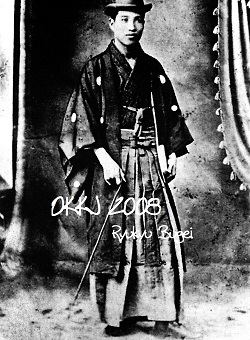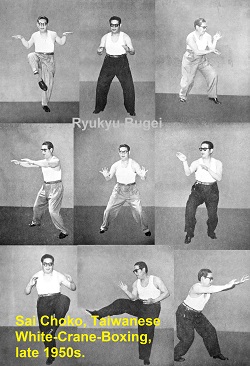There is a phase in one’s karate-life when you get extremely confused about kata and their origin. Naturally, you want to believe your karate is very authentic and old. However, without special skills and experience, even for world champions or national coaches it is quite difficult to research the lineage of many kata. Therefore, most Karate people get frustrated with such unrewarding practices such as the research of Kata history.
That’s alright.
Recently I presented a clue to the false representation of Chatanyara Kusanku: While it was acquired in the late 1950s from Nagamine Shoshin and kept intact for some time, it was then recreated, modified, and changed in the 1990s by one specific yet influential Karate faction. This influential Karate faction smuggled their new form into the JKF, and from there it reached the WKF. Today it has become a pet kata of many in the competition circus.
Another false “antique” tradition is Paipuren. See both kata here in an epic battle for KARATE gold 😉
Here’s yet another, more recent battle.
Great to watch.
 Paipuren is unanimously though ostentatiously described as a kata handed down by a certain Go Kenki, a Chinese man who lived on Okinawa from around 1912 until his death in 1940. Since he was an acquaintance of Mabuni Kenwa, and while there was never any evidence for it, in retrospective this would make the claim sound plausible that Mabuni has had personally learned it from him. If true, this would make Paipuren an early 20th century Okinawan karate tradition.
Paipuren is unanimously though ostentatiously described as a kata handed down by a certain Go Kenki, a Chinese man who lived on Okinawa from around 1912 until his death in 1940. Since he was an acquaintance of Mabuni Kenwa, and while there was never any evidence for it, in retrospective this would make the claim sound plausible that Mabuni has had personally learned it from him. If true, this would make Paipuren an early 20th century Okinawan karate tradition.
But even though Mabuni left for Mainland in 1929, you don’t see Paipuren in Okinawa anywhere else, do you?
What happened? Was Mabuni the sole person who learned Paipuren from Go Kenki?
The matter is very simple and moreover symptomatic (and also a bit disturbing): Paipuren is NOT a kata handed down by Go Kenki, nor anyhow related to Mabuni Kenwa.
So why is it presented in such a way? Why is it presented as if it was a personal tradition of Go Kenki and an original Shitō-ryū kata?
Answer: I really don’t know and I certainly don’t care.
Truth is, Paipuren was acquired by a student of Mabuni Kenwa around 1960. At that time, the person was not able to learn the complete form. The kata was taught in Taizhong in central Taiwan by a man called Chan Teiyū, who in turn was a disciple of famous White-Crane-Boxer Sai Chōkō.
Sai Chōkō was an influential Taiwanese businessman active in karate since the early 1950s. When in 1956 the original (old) Zen Nihon Karate-dō Renmei (JKF) was established as a unified organization of karate going beyond schools, Sai Chōkō became its president. At that time, Konishi Yasuhiro (Shindō Jinen-ryū) and Kinjō Hiroshi (Kanbukan) as vice presidents, and among the advisers were Ōtsuka Hironori (Wadō-ryū), Yamada Tatsuo (Nihon Kenpō Karate-dō), Gima Shinkin (Shōtōkan-ryū) and others. Later Tamotsu Isamu (Renshinkan) joind the board of directors, and Tōyama Kanken’s Shūdōkan is said to have served as the GHQ (sō-honbu).
Sai Chōkō was their boss.

Sai Choko. Courtesy of Hardy Holm.
Sai was a Taiwanese businessman who naturalized in Japan. He worked as a real estate business manager, cabaret manager, chairman of the Naigai Taimusu newpaper company, journalist of the Yomiuri Shimbun newspaper, editor of the Kōdōkan Jūdō Magazine and others. For his generous financial support he was awarded the Medal with Dark Blue Ribbon (Konju hōshō) and he achieved a 9th Dan in Karate-dō as well as an 8th Dan in Jūdō. As a side note, Taiwan was extremely important during the 1950s in the political world, too, and the West and Japan had long supported openly and opaquely its independence.
Back to Paipuren: After the kata had been initially – yet only partly – been acquired in Taiwan, Sai Chōkō gave a seminar of what was referred to as Pāpūren at the time in Nagoya City in Japan. Only at this time the person in question was able to completely learn Paipuren.
As was done with other kata, at some point Paipuren was added to the official kata list of the JKF. Since only Gōjū, Shōtō, Wadō, and Shitō were allowed in this kata list, Paipuren was placed under Shitō-ryū. How did this work you may ask. Well, simply by the majority the interested parties had in the voting process within the JKF. And from the JKF Paipuren reached the WKF. That easy.
And that’s all you need to know about Paipuren.
So when next time someone generously offers to teach you Paipuren as a personal tradition from Go Kenki to Mabuni Kenwa, and as an original kata of early 20th century Okinawan karate, then you know: There is no such thing.
In addition, next time you are overly critical with Westerners making up their own kata, remember Paipuren, smile, and give them a like.
© 2016 – 2020, Andreas Quast. All rights reserved.
